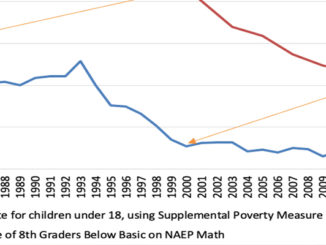
b
In the 11 years since Congress last reauthorized the Higher Education Act (HEA), student debt has climbed past $1.6 trillion; tens of thousands of students have been left worse off by poor quality institutions; and gaps in college attainment by race and income have continued to put the American dream out of reach for far too many.
Today, Rep. Bobby Scott (D-VA) introduced a nearly 1,200-page bill, the College Affordability Act, that would comprehensively reauthorize the HEA and tackle some of the biggest problems in postsecondary education. This column provides a brief overview of the most notable policies that the bill would implement if passed.
Tackling college affordability
A promise to students
The College Affordability Act would enact America’s College Promise, a program proposed during the Obama administration that offers tuition-free community college to students nationally. The program would be available to students attending school half time or greater, regardless of their age, and includes undocumented students. The bill would also make historically Black colleges and universities and other minority-serving institutions eligible for funding that would allow them to waive or significantly reduce tuition and fees for two years of their students’ schooling.
The program would be funded via a new federal-state partnership that leverages a major reinvestment from the federal government in exchange for states agreeing to shoulder some of the costs. To participate, states would have to cover just a quarter of the costs; tribal nations would need to cover just 5 percent.
To make sure that the infusion of new dollars is used to help more students succeed in college, community colleges would need to improve services such as mentoring and advising; assistance with issues such as child care, transportation, and public benefits; and pathways to transfer to four-year institutions. States would be expected to work on many of the same priorities and would be prohibited from reducing their support for higher education.
Streamlining the FAFSA for low-income students
With more than 100 questions, often requiring a deep dive into tax return data, the Free Application for Federal Student Aid (FAFSA) can be a barrier to low-income students’ ability to access financial aid. The College Affordability Act would change that: Prospective students who received any federal public benefit within the previous two years would no longer need to file a FAFSA, and all low-income students would only need to file the application once, when they start their college career.
Revitalizing the Pell Grant
The Pell Grant is the largest source of grant aid for low-income students, but unfortunately, its purchasing power has decreased, funding nearly 70 percent of the cost of a four-year public college in 1980 to less than 30 percent today.
The College Affordability Act would increase the maximum Pell Grant award by $500, to a total of $6,695, starting in 2022 and to an estimated maximum award of $8,305 by fiscal year 2029. Pell awards would be indexed to inflation to maintain the grant’s purchasing power, and students could receive the grant for up to 14 semesters, up from 12 today.
The Pell Grant would also be restored for justice-involved students. In 1994, Congress banned incarcerated students from receiving Pell Grants, severely limiting access to college and a proven recidivism reduction strategy. The program included in this bill, called Second Chance Pell, has bipartisan support and includes safeguards to ensure that the educational opportunities offered to incarcerated students are of high quality.
Unfortunately, the bill also includes provisions that could put Pell at risk in the future. It opens up Pell eligibility for job training programs as short as eight weeks, which have shown little evidence of high payoff in the job market. The bill also makes graduate students eligible to receive Pell funding if they have remaining eligibility after finishing their undergraduate credential. Though both programs could provide some students with access to additional postsecondary options, they could also put the program at risk, providing grant aid to programs that offer a poor return on investment and failing to prioritize the need of undergraduates enrolled in high-quality degree programs.
A simpler way to repay loans
The College Affordability Act would make big changes to how borrowers repay student loans. It reduces the current suite of confusing repayment plans to just two: a fixed payment plan, which allows borrowers to extend their repayment term as their debt balance increases, and an income-driven repayment (IDR) plan. The IDR plan provides more generous terms than any currently available, exempting more income, providing forgiveness after 20 years of payments, and being open to all borrowers. Severely delinquent borrowers would also be automatically enrolled in the IDR plan, a measure that could significantly reduce the likelihood of default, particularly for low-income individuals.
The bill also simplifies Public Service Loan Forgiveness and the Teacher Education Assistance for College and Higher Education (TEACH) Grant, making them more straightforward and available to more borrowers. It also limits interest capitalization, which can saddle borrowers with higher balances and longer payoff time frames.
There are also plans to make default less punitive. Should a borrower in default repay their loan in full, the bill requires credit reporting agencies to remove the record of default—a vast improvement over current policy, which leaves the default in place, making it difficult for the borrower to get a mortgage or buy a car. Additionally, the bill reinstates a statute of limitations on debt collection, preventing borrowers from experiencing collections after six years of being in default. Though more should be done to help borrowers who face the worst loan outcomes, these are important first steps down that path.
The bill also introduces some controversial elements that will likely stir debate. For example, it allows borrowers to refinance or consolidate their federal and private education loans, including Parent PLUS loans, though exactly who qualifies would be based on income thresholds determined by the U.S. secretary of education. Though some of these policy proposals, such as refinancing, have been around for quite some time, they have fallen out of favor as demands for loan forgiveness have grown. They have also been criticized by analysts as an expensive fix that concentrates benefits among the highest-income borrowers.
Accountability and quality oversight
The College Affordability Act would make enormous strides in the accountability that colleges face, quality of oversight of their work, and protections for students who receive a poor-quality education.
Improving transparency and oversight of programs and colleges
The bill tackles several areas where advocates have long demanded more accountability. It fixes a policy frequently referred to as the 90/10 rule, which requires for-profit colleges to receive no more than 90 percent of their revenue from the federal government. The current calculation does not count government-funded veterans’ education benefits toward the 90 percent, a loophole that is corrected under the College Affordability Act. The bill also reduces the revenue share to 85 percent, putting additional pressure on colleges to rely less on federal funds.
The bill also recommits to two Obama-era regulations aimed at reducing the proliferation of low-quality programs and deceitful or predatory practices: gainful employment and borrower defense to repayment. The former rule bars a program from leaving students with more debt than they can afford, and the latter provides debt relief and reinstates Pell Grant eligibility for students whose schools engaged in fraud or misrepresentation. On gainful employment, the education secretary would be required to regulate on a measure used to hold institutions accountable if they leave students with more debt than they can repay based on their earnings. On borrower defense, the bill codifies some parts of the Obama-era regulation that allows students to apply for loan discharges.
The bill would also reestablish an enforcement unit within the Department of Education to review and investigate allegations of unfair, deceptive, or abusive practices among institutions and their contractors. What’s more, the secretary of education would be responsible for conducting “secret shopping” to make sure that colleges don’t violate ethics rules or engage in aggressive practices when they recruit students.
Finally, the bill directs the Office of Federal Student Aid (FSA) to adopt a more student-centered mission. It requires the FSA to publish additional information about loan servicers and other contractors; creates an Office of the Borrower Advocate under the FSA to help borrowers resolve complaints; and implements a common manual to instruct student loan servicers on consistent, high-quality standards of practice.
New responsibilities for accrediting agencies
The bill would make the most significant improvements in decades to the accreditation system, which serves as the gatekeeper for the $120 billion that the federal government spends on financial aid each year. The federal government relies heavily on accrediting agencies, independent, and nonprofit organizations to vet institutions, and the Education Department sets their rules and reviews their work. Today, that process is deeply inadequate, and the new bill would demand more robust department oversight of accreditors.
The bill would require accreditors to set standards for colleges on student achievement, including on completion and workforce participation, and track achievement gaps by race and income. The agencies would also have new responsibilities when a college appears to be in danger of closing. Accreditors would be required to obtain teach-out agreements, formal contracts that give students guaranteed transfer options in the event of a closure. Accrediting boards would also be required to eliminate conflicts of interest with colleges and strengthen the role of members who represent the public.
New debt accountability metrics
The College Affordability Act retools how colleges are held accountable and ensures that schools adequately prepare students to earn enough to repay their debts. The bill reimagines the cohort default rate, closing loopholes, reducing thresholds, calculating the metric down to the credential level, and extending the oversight time frame from three years to eight years in order to ensure that borrowers’ longer-term well-being is captured by the metric. It takes into account the share of students who borrow to ensure that the rate reflects the student population. The bill also adds an on-time repayment rate—defined as the share of borrowers who make at least of 90 percent of their payments on time—to ensure that schools are held accountable for providing borrowers with a credential that will allow borrowers to pay down their debt.
Bringing student outcomes out of the shadows
In the last HEA, Congress banned the federal government from collecting student-level data. But the absence of such data makes it difficult to understand students’ pathways through college. The College Affordability Act would overturn this ban by including the College Transparency Act (CTA), a bill with bipartisan support. The CTA would establish a data system that tracks students from enrollment to transfer to graduation and beyond as well as allows the collection of various demographic characteristics to better understand equity gaps. The new data system would be designed to address privacy concerns and protect personally identifiable information from misuse.
Room for improvement
Though the College Affordability Act does a lot of good for the nation’s postsecondary system, there are several elements of the bill that require larger discussion before being enacted. Short-term Pell Grant and student loan refinancing can provide benefits to some students, but in a world of limited resources, it is necessary to consider if those programs are funneling federal funds in the right direction. There are also issues that cross jurisdictions that need to be addressed. For example, the bill attempts to direct the IRS to share data with the Education Department, but that almost certainly requires statutory reform from the House Ways and Means Committee. Thus, it will take an effort from the entire House of Representatives to ensure that the College Affordability Act is effective in implementing the policies it lays out.
Conclusion
There is much more to the College Affordability Act than has been described here. It provides significant revisions to and investments in current programs, such as federal work-study and the Federal Supplemental Educational Opportunity Grant, and creates competitive grant programs that would bolster institutional resources.
Though the bill could receive broad-based support on and off the Hill, its path in the Senate is unclear, as ranking members on the Senate Health, Education, Labor, and Pensions Committee have been trying to hammer out an agreement on the Senate’s approach. Though the College Affordability Act will likely not be adopted whole cloth, it provides a strong signal that a comprehensive, reform-minded approach is needed to make the higher education system work for all students.
Colleen Campbell is the director for Postsecondary Education at the Center for American Progress. Antoinette Flores is an associate director for Postsecondary Education at the Center. Marcella Bombardieri is an associate director for Postsecondary Education at the Center. Victoria Yuen is a policy analyst for Postsecondary Education at the Center. Marissa Navarro is a special assistant for Postsecondary Education at the Center. Dante Barboy is an intern on the Postsecondary Education team at the Center.



